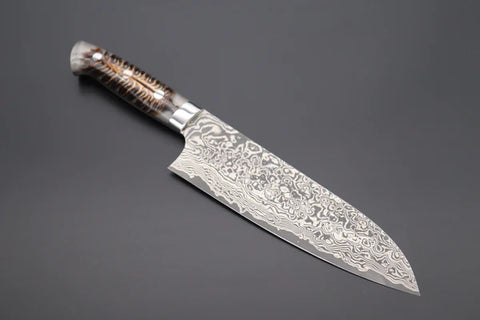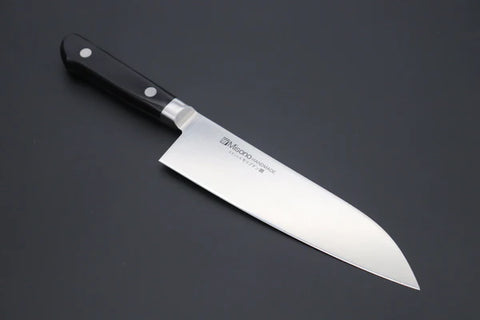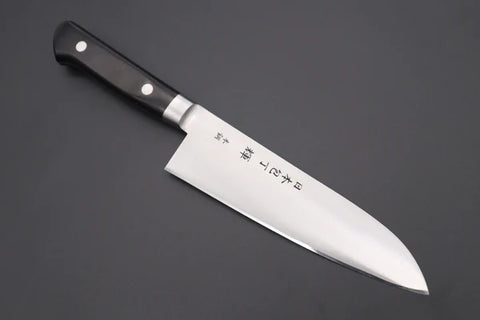We Offer DHL EXPRESS Flat Rate Shipping Worldwide. Just $10 USD for US, Canada, Australia, Asian countries. US$15 for Europe and other Countries in the world
For our U.S. Customers — No extra fees! All orders ship via FedEx DDP (duties & tariffs are covered by JCK). Enjoy fast, worry-free delivery! Learn More
We Offer DHL EXPRESS Flat Rate Shipping Worldwide. Just $10 USD for US, Canada, Australia, Asian countries. US$15 for Europe and other Countries in the world
November 15, 2023

In the quest to find the perfect kitchen tool, chefs compare various models to discover a Santoku knife that aligns with their culinary expression, valuing its versatility across multiple tasks. This knife, a blend of tradition and modernity, is sought after for its ability to adapt to the diverse demands of kitchen prep, from slicing delicate fish to chopping hearty vegetables.
Our analysis delves deep into the world of Santoku knives, examining their performance to guide you through a thoughtful selection process. The resulting guide emerges from a meticulous examination, providing a valuable resource for those looking to enhance their culinary toolkit.
The essence of this article is to shed light on the Santoku knife, presenting a curated collection of top-tier options. It equips cooks and chefs with comprehensive reviews and comparison charts, ensuring that the choice they make is as informed as it is inspired.
OPTION | PRICE | BEST FOR | WEBSITE |
Gekko Blue | US$150 | Versatility | |
Saji SUMMIT | US$510 | Unique Forged Hammer & Custom Made | |
Misono Molybdenum | US$103 | Affordability & Quality | |
Kagayaki CarboNext | US$120 | Carbon Steel Enthusiasts & Quality | |
Hattori FH-4L | US$256 | Premium Quality |
A comparison table of the best Santoku knives.
JCK Natures "Gekko Blue" Santoku: Ideal for chefs who value both functionality and aesthetic appeal in kitchen tasks.

Takeshi Saji SUMMIT: The top choice for connoisseurs and collectors who appreciate the artistry of custom-forged knives.

Misono Molybdenum Steel Series Santoku: A practical selection for daily kitchen activities, offering quality at an affordable price

JCK Original Kagayaki CarboNext Series KC-3 Santoku: Suited for both beginners and seasoned chefs who seek the edge retention of carbon steel without the usual upkeep.
Hattori Forums FH Series FH-4L Santoku: Optimal for culinary professionals who demand a knife that delivers precision and is crafted with attention to detail.

The "Gekko Blue" Santoku Knife, with its Royal Blue-Purple Pakka Wood Handle, is not only unique in color but also water-resistant. Its VG-10 stainless steel blade core is renowned for robust quality. Priced at US$150, the knife embodies craftsmanship and elegance. Designed for precision and longevity, it is a tool essential for culinary excellence.
Takeshi Saji SUMMIT Santoku The Takeshi Saji SUMMIT, a limited edition Santoku knife, stands out with its 180mm (7 inches) dark R-2 Damascus blade, forged from Powdered Metallurgy High Speed
Tool Steel. Priced at US$510, this knife is a testament to the 74-year-old forge smith Takeshi Saji's expertise,

hailing from Echizen City. Developed since 2020, each knife in this exclusive series is a unique, limited edition piece, featuring a rare, transparent super silver-colored stabilized spruce cones hybrid wood handle.
This handle, designed for comfort and aesthetics, is secured with a decorative mosaic pin and balanced with a stainless steel bolster. The Santoku's tall blade and rounded tip make it a versatile tool for slicing meat, fish, or vegetables, embodying its "Three-purpose" essence as a multi-purpose kitchen knife.
 inch) size, priced at US$103. Known for their craftsmanship, Misono presents this knife as part of their most accessible range. Crafted from AUS-8 high carbon 13 Chrome Molybdenum stainless steel, the blade boasts a hardness of HRc. 57, ensuring corrosion resistance, durability, and ease of sharpening. The knife features a full tang construction, a water-resistant black pakkawood handle, and stainless steel bolsters for enhanced durability and balance. The Santoku's design, tailored for versatility, is adept at handling meat, fish, or vegetables, living up to its "Three-purpose" name as a multi-purpose kitchen knife.
inch) size, priced at US$103. Known for their craftsmanship, Misono presents this knife as part of their most accessible range. Crafted from AUS-8 high carbon 13 Chrome Molybdenum stainless steel, the blade boasts a hardness of HRc. 57, ensuring corrosion resistance, durability, and ease of sharpening. The knife features a full tang construction, a water-resistant black pakkawood handle, and stainless steel bolsters for enhanced durability and balance. The Santoku's design, tailored for versatility, is adept at handling meat, fish, or vegetables, living up to its "Three-purpose" name as a multi-purpose kitchen knife.


When selecting the ideal Santoku Knife, assess the blade's material to ensure it meets the demands of your culinary tasks, such as slicing meat or chopping vegetables. The comfort of the handle is crucial for ease of use. The right Santoku Knife will not only be suited to your specific tasks but will also elevate your cooking experience.
The Santoku knife, a jewel in the crown of Japanese culinary tools, is a versatile kitchen companion. Its name, meaning "three virtues," speaks to its proficiency in three fundamental cutting tasks: slicing, dicing, and mincing. Whether you're preparing vegetables, filleting fish, or carving meat, the Santoku knife's sharp blade and balanced handling make it an indispensable tool for both novices and seasoned chefs alike.
Selecting between a chef knife and a Santoku is a pivotal decision in the kitchen. The chef knife stands out with its curved blade, designed for rocking cuts, and is uniquely versatile. In contrast, the Santoku features a straighter edge and a thinner blade, attributes that make it ideal for precise, straight cuts. The choice often depends on the culinary tasks you prioritize.
For those who value precision and prefer the finesse of a lightweight blade, the Santoku, typically sized between 170mm to 180mm, aligns with your needs, especially for short to medium-sized foods. However, if your culinary adventures often involve cutting larger foods, the Gyuto, or chef knife, with its variety of sizes ranging from 150mm to 300mm, may be the more suitable option. This versatility allows the chef knife to adapt to a broader range of tasks, making it a classic choice for those who appreciate a more substantial knife in the kitchen.
This additional size information is crucial as it guides customers in making an informed decision that enhances their cooking experience.
Yes, professional chefs often reach for a Santoku knife to execute a range of tasks with grace and efficiency. Its design is particularly conducive to the fast-paced environment of professional kitchens. The Santoku's shorter blade allows for swift, controlled movements, making it a go-to for chefs who prioritize speed and precision.
Santoku knives are indeed suitable for cutting raw meat. Their sharp, straight edges are designed for clean cuts without the need for sawing. The thinner blade slices through meat with less friction and more control, which is ideal for creating perfect cuts of raw meat for your dishes. However, for tougher cuts or when dealing with bones, a heavier, more robust knife like a Western Deba might be more appropriate.
Santoku Knife: What Is It Used For?
The Santoku Knife, a term that originates from the Japanese for "three uses," is a culinary marvel celebrated for its proficiency in slicing, dicing, and mincing a variety of ingredients including meat, fish, and vegetables. This multipurpose tool has sparked a conversation in the culinary world, leading to a plethora of Santoku knife reviews that highlight its precision and ease of use. When it comes to the Santoku knife vs chef knife debate, the Santoku is often lauded for its shorter and more manageable blade, which is designed for those who value meticulousness in their kitchen endeavors.
While exploring the best Santoku knife options, one will find that they come in a range of prices and are often available as part of a Santoku knife set, offering versatility and value. These sets are a favorite among home cooks and professional chefs alike, providing a selection of blades to tackle various culinary challenges.
In pursuit of the best Santoku knife, enthusiasts often weigh factors such as blade quality, handle comfort, and overall performance. The Santoku knife price can vary, but investing in a high-quality knife ensures longevity and enduring sharpness. Whether you're finely chopping vegetables or seamlessly slicing through fish, the right Santoku knife is a testament to exceptional craftsmanship and a staple in the kitchen.
In summary, to identify the ideal Santoku Knife for your culinary arsenal, you must find the options available, compare their features rigorously, and evaluate how well they align with your cooking needs. Whether you value a knife's adaptability, its standout design, or cost-effectiveness, there exists a Santoku Knife that aligns with your distinct preferences.
The final comparison table once again lays out the top choices, making your decision process as seamless as possible.
OPTION | OUR SCORE | BEST FOR | WEBSITE |
Gekko Blue | ★★★★★ | Versatility | |
Saji SUMMIT | ★★★★★ | Unique Design | |
Misono Molybdenum | ★★★★★ | Affordability | |
Kagayaki CarboNext | ★★★★★ | Carbon Steel Enthusiasts | |
Hattori FH-4L | ★★★★★ | Premium Quality |
A final comparison table of the top best Santoku knives.
October 28, 2025
Love knives that cut like a dream and look like art? This guide breaks down Master Takeshi Saji’s six core series. Compare steels (VG-10, R-2/SG2, SRS-13, Aogami Super, Ginsan), handle materials, prices, and maintenance. I show who each series suits—daily drivers, carbon-steel purists, and collectors—so you can pick your perfect Saji with confidence.
September 12, 2025
The Usuba knife is a traditional Japanese single-bevel blade designed for precision vegetable work, from paper-thin katsuramuki peeling to intricate mukimono garnishes. In this guide, we explore the three main types—traditional Usuba, curved-tip Kama Usuba, and delicate Mukimono—while reviewing the best models from Masamoto, Mizuno, and Fu-Rin-Ka-Zan. Whether you’re a home cook seeking cleaner cuts or a professional chef aiming for flawless artistry, the right Usuba can transform your kitchen prep.
August 30, 2025
A high-quality Japanese paring knife can turn tedious prep into precision cooking. From peeling apples to deveining shrimp, these small, razor-sharp blades excel at in-hand tasks. After testing dozens over two decades, here are my top picks for sharpness, control, and craftsmanship — plus tips on choosing the right steel, size, and handle for your needs.
Sign up to get the latest on sales, new releases and more …
